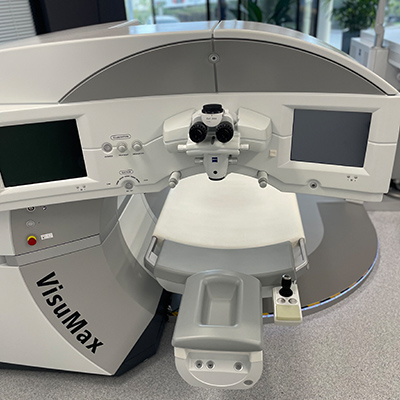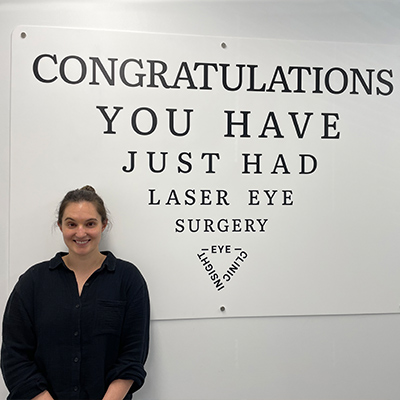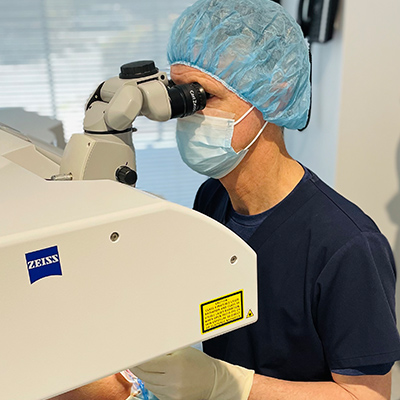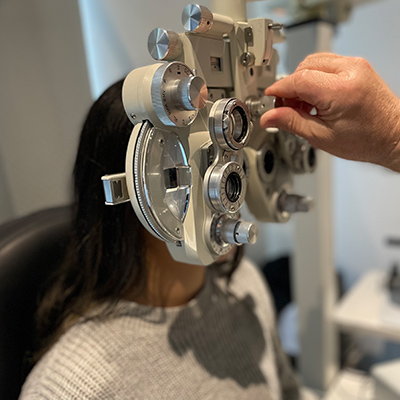Cataract Surgery – Do I Really Need It?
Before we can discuss whether or not you really need cataract surgery… let us discuss what a cataract is and how it effects your vision.
What is a cataract and why do they form?
Cataracts are most commonly age-related and are formed from a change of the proteins within the crystalline lens. The crystalline lens sits just behind your iris (the coloured part of the eye) inside of your eye. This build up causes a clouding of the lens. The clouding of the lens keeps light from passing through the eye and causes reduced vision. Other causes of cataracts include:
- An inherited congenital condition – Approximately 0.4% of babies are born with congenital cataracts which are a result of one of many causes whilst in utero and sometimes require immediate surgery and other times, are left until later in life when the foggy lens begins to effect the vision more.
- Traumatic – Traumatic cataracts occur secondary to blunt or penetrating ocular trauma.
- Medication – Long-term use of steroids and diuretics can cause an early onset of cataracts.
- Radiation – Exposure to toxic substances, ultraviolet light (specifically UVB) and microwave radiation has also been found to cause cataracts.
- Underlying medical condition – Often, one medical condition will contribute to the development of others and most commonly, diabetes is found to directly affect our eyes, whether it be contributing to or progressing the development of cataracts or diabetic retinopathy which is also a leading cause of blindness is those under 65.
Cataracts are the cause of half of blindness and 33% of visual impairment worldwide

How will cataracts affect your vision?
In order to see an image clearly, light passes through the pupil of the eye, then through the lens, which sits just past the iris (the coloured part of the eye). The light must be able to reach the retina without interference.
When a cataract forms on the lens and it goes from being clear to milky or cloudy, much less light is able to reach the retina. Images often become blurry and lacking in vibrancy (see flower image on left).
Some common symptoms of cataracts are: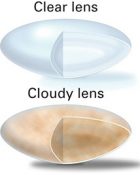
- Vision that is cloudy, foggy, blurry or filmy
- Light sensitivity (particularly at night), glare and halos which can cause difficulty whilst driving
- Yellowing or fading of colours
- Constant changing of glasses or contact lenses with little improvement to vision
- Double vision in the affected eye
Can my vision improve with visual aids such as glasses or contact lenses?
 No, glasses and contact lenses can not help you regain the vision that has deteriorated as a result of a cataract. They can only improve short-sight, long-sight, astigmatism, presbyopia and some levels of strabismus (aka squint).
No, glasses and contact lenses can not help you regain the vision that has deteriorated as a result of a cataract. They can only improve short-sight, long-sight, astigmatism, presbyopia and some levels of strabismus (aka squint).
Once visual acuity is affected by the cataract, so is the ability to do the daily things we often take for granted. This might be driving, reading, cooking or seeing our loved ones faces clearly. Many people lose their driving license which can take a massive toll on their independence and quality of life. If you are currently suffering with what appears to be the beginning of cataracts, please seek attention to ensure you can have your procedure within a suitable time frame, before it affects your day to day quality of life.
What happens during cataract surgery?
The procedure is likely to take only 20 minutes although you will be at the hospital for approximately 3 hours. During this time, you will be met by the nursing staff who will go over some pre-admission questions with you and prepare you for your procedure. In most cases, surgery for each eye is performed on separate days, usually 3-14 days apart.
Most patients have a local anaesthetic to numb their surgery eye. This is in the form of an eye drop and a mild sedation to help with any nerves or anxiety.
Dr Furness will guide you through the procedure and advise you where to focus. You should NOT experience pain during your procedure, occasionally you might experience a small amount of pressure usually preceded with a caution from Dr Furness. A 2mm slit is made in the cornea and your doctor will use a small instrument to break up and remove the cloudy lens from inside the eye. Once removed, Dr Furness will then insert the new lens and position it in place. No sutures are needed as the incision is so small. Your eye begins to heal immediately.
A quick post-operative check is performed on the day of your procedure or the following morning to check the pressure of the eye as it is very common to see a temporary increase in ocular pressure after surgery. Various solutions are available if you experience this so please do not be alarmed. (Click here for a video overview of cataract surgery).
If I have always worn glasses, will I still need glasses after cataract surgery?
During your consultation, Dr Furness will assess what type of vision is best suited to your day to day life. Occupation, hobbies and personal preference are all considered to ensure that your vision after surgery is to the highest standard and your liking. There are various types of lenses and vision outcomes for patients:
- Monovision (aka blended vision) – Monofocal lenses are used to correct the dominant eye for distance vision and the other for near vision meaning it is unlikely you will require glasses after your procedure but in some cases, people require glasses for finer tasks such as needlework or very small print or long distance driving. 20% of people’s brains cannot adapt to this visual result and find they experience a sea-sick feeling or problems with depth perception. A contact lens trial is sometimes necessary and allows us to simulate monovision which is how your doctor determines the suitability of this visual outcome. Other procedure types are available for those that cannot adapt to monovision. For the 80% who’s brains’ do agree with this outcome, they are generally extremely happy.
- Trifocal lenses – Trifocal lenses feature a series of rings which diffract light to allow you to have very good distance, intermediate and near vision. The same lens is used in both eyes meaning that you will not experience the same imbalance that some get from monovision. Dr Furness, from Insight Eye Clinic, has researched the most advanced lenses to give his patients the best possible visual result when having their cataract procedure. Follow this video link for a visual demonstration on how Trifocals could benefit you.
- Distance vision in both eyes – Using a monofocal lens to correct both eyes for distance vision means that you will require reading glasses after your procedure, even if they were not required before. Some people prefer both eyes for distance vision if they experienced an imbalance with monovision, a large amount of glare or halo’s with trifocals or are happy to wear reading glasses. We find that the people who are most happy with this visual outcome, typically have a very high refractive error before their procedure. This visual outcome might also be preferable for occupational reasons. For ex: truck drivers who rely heavily on sharp distance vision without risk of glare or halo’s at night.
We cannot guarantee that you will not need glasses again. Sometimes vision needs a little assistance to reach a higher level of clarity depending on the vision outcome chosen.
Can the cataract come back?
No, once the diseased lens containing the cataract has been removed, it cannot return. In most cases, the patient must return within the first 1-3 years for a quick, safe and easy procedure called a YAG laser treatment. Some clouding can occur on the new intraocular lens which mimics the vision caused by cataracts. This is simply a build up of debris that can be easily removed in clinic using a laser to clear the opacification. Following this treatment, vision can be blurry for a short period, perhaps a few hours. Usually by the following day, vision has rapidly improved and returned to its maximum clarity.




